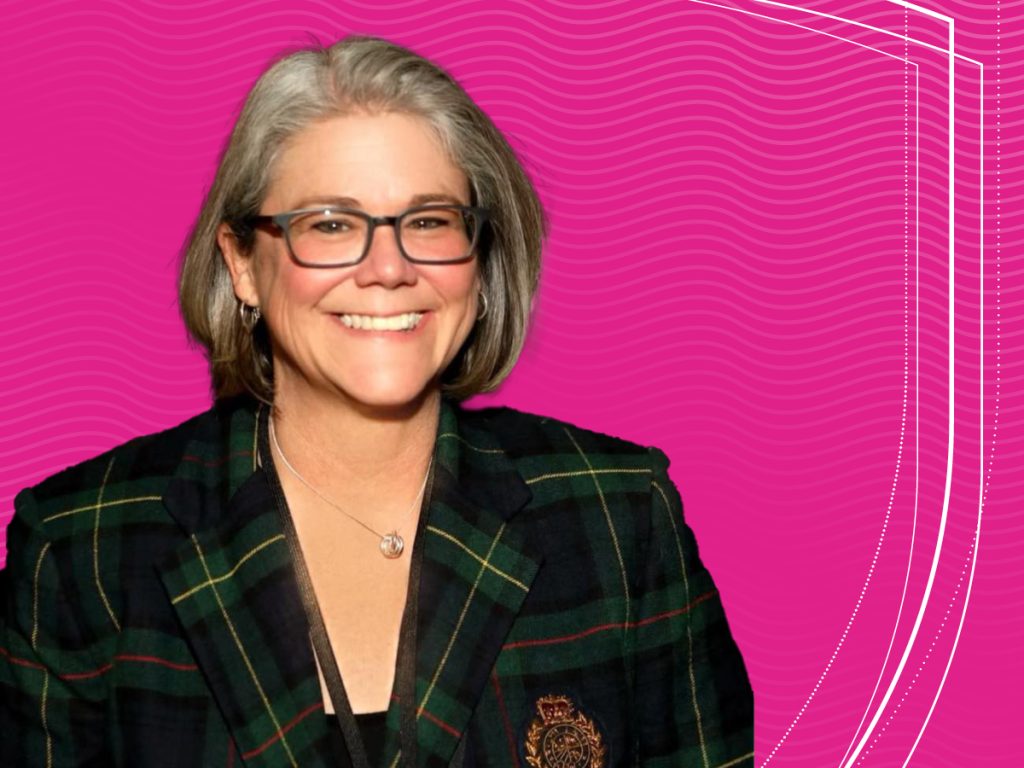
“Barbie,” the Greta Gerwig-directed film about the iconic doll, is now Warner Bros.’ highest-grossing domestic release, earning $537.4 million at the U.S. box office as of Aug. 16, beating the former title holder, the 2008 film “The Dark Knight,” which amassed $536 million, according to CNBC.
In an effort to explore the significance of the film and its popularity, Penn State Berks Strategic Communications interviewed Michele Ramsey, associate professor of communication arts and sciences and of women’s, gender and sexuality studies. Ramsey is a frequent media contributor on issues concerning women’s studies and communication.
Michele Ramsey’s research interests include representations of gender in the media, women’s rights rhetoric, social movement rhetoric, and political rhetoric, and advocacy for the humanities. She earned a doctorate in speech communication from the University of Georgia, a master’s degree in communication studies from the University of North Texas and a baccalaureate of applied arts and sciences degree in political science, from the University of North Texas.
Q: Why did you see the movie? Was it because you enjoyed playing with Barbie as a young girl or because of your interest in women’s studies?
Ramsey: Initially, I was not interested, even though I had confidence in Greta Gerwig as the director and Margot Robbie and Ryan Gosling as the leads. I was not a Barbie kid and so I didn’t have any intrinsic interest in the movie. But once people started talking and I could tell there was a feminist rhetorical angle to the film, and as a feminist, women studies and communication professor, and fan/professor of pop culture, I knew I needed to see it.
Q: Did you see the movie when it first opened? Did you enjoy it (or parts of it)? Did you dislike other parts? Please explain.
Ramsey: I saw the film in its first week and overall, I enjoyed it. The casting was excellent, the world they created was fun to watch and to look at, and it had a lot of funny moments. America Ferrera’s soliloquy on the double standards and mixed messages our culture sends us about femininity and womanhood was outstanding and, I think, really hit a home run in terms of encapsulating what Gerwig invited us to think about while watching the film.
Q: What was your relationship with Barbie as a young girl? How did it change over the years?
Ramsey: Growing up in the ’70s, I was not a Barbie kid, or even very interested in any dolls, save my Donnie and Marie Osmond dolls. I did like that she had a cool house and car, but I wasn’t particularly big into “playing Barbie” and I don’t remember owning one. And I think growing up in the ’70s was important in terms of those choices because I was growing up in the midst of a lot of positive changes for women, thanks to second-wave feminism, and so I perceived that I had other options in life that most women born before me didn’t have much access to in terms of careers.
I don’t think most people realize that even in the late ’60s and well into the ’70s, women were barred from certain majors in college, like science. Or that until the ’70s, they couldn’t have a credit card in their own names, divorce their husbands for “irreconcilable differences,” or have legal recourse if their husbands were sexually assaulting them. So, these changes, like Title IX and other equality-based laws, were life-changing for my generation. Thus, I was only marginally interested in the kinds of toys that were typical for girls who grew up before me because they just didn’t connect to my interests, which were primarily music and soccer, a game that girls were just beginning to play in the ’70s.
The way that my relationship with Barbie changed over the years was linked to my college education. Taking my first gender and communication course as an undergraduate, I became aware of the political, social and economic impacts of Barbie’s popularity and those realizations were troubling. For example, Barbie’s proportions would’ve made it impossible for her to walk on two feet, she wouldn’t be able to lift her head, and she would be diagnosed as anorexic. Scores of research studies have connected Barbie to very negative impacts on the body and self-images of females. Once you learn these things, it’s hard to be a fan of Barbie, even as I appreciate the creator’s intent on giving girls a doll that encourages them to play more than just “mom.”
Q: What early influences shaped your outlook on feminism?
Ramsey: I had great role models growing up, including my mom, aunt, and maternal grandmother and so I knew I had options other than those typically labeled “for women,” which had limited girls growing up before I was born. Feminism is about giving people the chance to decide what to do with their lives, regardless of societal sex or gender role expectations.
Q: What is Gerwig inviting audiences to think about in her movie?
Ramsey: Gerwig very clearly tries to teach us about patriarchy in the film. Patriarchy is a system in which males maintain control over society and government and exclude women from those roles. For example, in the United States, even though women are about 51% of the population in our country, we lead only about 10% of Fortune 500 companies. U.S. women also account for only 28.7% of the members of the House of Representatives and 25% of the Senate. According to the Pew Research Center (2022), compared to white, non-Hispanic men, white women still only made about 83 cents on the dollar while Black women still made only 70 cents on the dollar, and Hispanic women/Latinas still earned only 65 cents on the dollar. Change has been very slow and those who encourage patriarchy, either consciously or unconsciously, discourage changes in our culture that can help these important shifts continue to improve.
And while I think Gerwig achieves her goal to a good extent, I was disappointed in one primary way. I think that the film could’ve made a stronger connection between Barbie and how what she has represented may have encouraged and helped maintain patriarchy. For example, while it is pointed out in the film that Barbie is not a realistic physical aspiration for those who identify has female, there is no discussion of how that fact props up patriarchy by inviting body image issues in girls that encourage eating disorders and their focus on physical appearance over things like intellect. That connection may be implied but it is never explicitly communicated in the film.
Q: Overall, how would you rate the movie?
Ramsey: Overall, I’m very glad the movie was made. I think that it has sparked some important conversations about the lives of women, the unrealistic physical expectations that have always hounded women, and the negative impacts of patriarchy. Though not a scientific study, I read on Resume Builder website that an August Pollfish survey of 300 U.S. respondents who saw “Barbie” found that two-thirds noted that the film helped them see patriarchy in the workplace. That’s great news!
We have a concept in rhetorical studies called perspective by incongruity, which is when we take a term or concept we assume we understand out of its typical context and put it into another context, which helps us see that term in a different way. There are two primary ways that this happens in “Barbie.” First, it is clear at the beginning of the film that the Kens only feel seen or important when the Barbies give them attention. They cease to “live” and even move if the Barbies aren’t interacting with them. This shift gives audiences the chance to think about how we tend to define women primarily in relation to men. For example, we have only one way to address men (Mr.), but we have three ways to address women and those words are typically linked to marital status (Miss, Ms., and Mrs.). And few know this, but Mr. stands for “Master,” thus Mrs. is the abbreviation of “Master’s”—literally defining a woman as property with that apostrophe “s”.
And while women who choose to go by Mrs. are likely doing so for tradition’s sake, not because they consider themselves their husband’s property, it’s a great example of how language reflects social reality. Similarly, the tradition of a father “giving away the bride” stems from coverture, which made women the property of their fathers first and then of their husbands. These things have been/were “normal” for a long time, but when the Barbies put the Kens in positions of being defined only by their relationships to the Barbies, people stop and say, “Hey! It’s not cool to only define a person by their relationship to another person!” And they’re right!
Second, I was disappointed that the immediate response of the Barbies to the patriarchal takeover of “Barbieland” was to encourage a fierce matriarchy because the message of feminism is that we all deserve equal opportunities to do what we want with our lives and that those decisions shouldn’t be made for us based on biased sex and gender roles. But, I can appreciate how that part of the narrative functioned rhetorically to put men in the position women have been in our country and around most of the world for centuries. That shift invited audiences to think about the fundamental unfairness of having one group control another based on gendered stereotypes.
Gerwig effectively used perspective by incongruity to get people to see the world in a way that invited them to think about the problems of deep structures like patriarchy and white supremacy and, in the end, offered audiences different possibilities for seeing the world and existing in it. These are things that, perhaps, they wouldn’t have thought about otherwise, and that’s very important work for a film to do.
Q: What do you think about the Barbie craze?
Ramsey: I think that the unrealistic nature of her looks and proportions have a horrible impact on many girls (and we shouldn’t forget that there’s likely a similar impact on boys who play with “action figures” who have impossibly muscled bodies, as well). And you can make her “President Barbie,” but that only dresses up those same unrealistic expectations in different clothes. In other words, keeping her the same physically but making her skin color or profession different effectively limits the doll’s ability to shift perceptions about women that damage young girls and boys into adulthood.
That said, I’m thrilled that the movie was made because it has started important conversations and has invited audiences to think about issues like patriarchy, body and self-esteem concerns, and feminism. I am hopeful that Hollywood will finally get the message that films for and/or about women are moneymakers. This film isn’t popular because it’s about an iconic toy. It’s popular because of the discussions that Gerwig encourages around that iconic toy and her impact on our culture and on our lives. My hope is that as children clamor for Barbies and Kens now that the movie has done so well, parents will engage in conversations about the need for equality, unrealistic body images, and the nature of sex and gender roles as socially constructed, rather than as biological imperatives. If they do, playing with Barbie and Ken can be a very different experience for children than it was for children reared before the movie was released.
As someone who teaches a course about the rhetoric of American horror films, I’ve had to answer the question “Why encourage students to study popular culture?” many times. And the answer is that it’s important because so much of what we learn about our world and our relationship to it comes from popular culture, be it films, television, video games, books, toys, music, etc. We often craft our own identities and make determinations about how well we “fit” into the world or who we “should like” based on what or who we learn is “good” or “bad” in popular culture. So any time a film can get folks to think about the impact of popular culture on their lives and how persuasive it can be, I’m thrilled! And we’ll certainly be talking about “Barbie” in my gender and communication class this fall.




